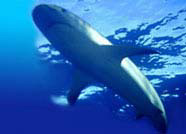


Scalloped hammerhead shark

 |
 |
 |
|||
| Home | Evolution
| Classification
| Glossary | Biology
| Behavior | Shark
Repellent | Shark
Conservation | Do's &
Don'ts | Did You Know?
Scalloped hammerhead shark |
 |
||||
|
 Scientific
Name: Sphyrna lewini Scientific
Name: Sphyrna lewiniScalloped hammerheads congregate in large, female-dominated shoals. They get their name from the undulated margin of the hammer-like head. The body is golden bronze, though appears grey at depths. The forward edge of the head is scalloped with five indentations. The first and second dorsal fins are not especially high. They are also known as kidney-shaped sharks. The front of the head of this shark is flattened, scalloped and wide, forming a structure called a cephalofoil. This oddly shaped head helps the shark swim, making the shark more hydrodynamic. The eyes are at the tip and slightly below the head. The head is also dense with sensory receptors. This is probably the most abundant hammerhead. It's found in tropical to warm-temperate waters worldwide, but its not yet known whether they occur in the Mediterranean. They are capable of long range migrations through open water. They prefer cooler water and are therefore often encountered at depth. They feed on a wide range of bony fish and small sharks. They also find fish buried in sand and may feed on these in lagoons at night. Scalloped hammerheads are frequently observed on deep dives, singly, in-groups, or even in large schools. The majorities are timid and difficult to approach, though larger solitary individuals may be dangerous. During the daytime, they congregate in large polarized schools of 20-100 fish, all the individuals swimming in approximately the same direction, apparently following the sharks in the leading ranks. Females outnumber males by up to four to one in these schools, the purpose of which is still unsure. It seems unlikely to be safety in numbers, or feeding, but may be to do with mating, though this hasn't yet been observed. The scalloped hammerhead is viviparous and the yolk sac placenta is closely tied to the uterine wall. They give birth to litters of 4-37 live young, they are 17-22 inches (43-55 cm) long at birth Hammerheads are caught primarily for the oil in their livers, which is especially rich in vitamin A. The vitamin content of the oil depends on how well nourished the individual is when caught. Vitamin D is never abundant in sharks' livers, presumably because it is associated with bone development, and sharks require a minimum for their cartilaginous skeletons. The arrival of artificial vitamins after World War II meant the demand for sharks plummeted. The trade for sharks is falling, although there is still a demand for hammerheads as a source of vitamin A in India. Statistics: Maximum size is about 4m, but most are between 2-3m. Scalloped Hammerhead Shark Classification:
|
|||||
| Sitemap | Reach To Us | Jimtrade - Business Directory of India | |||||